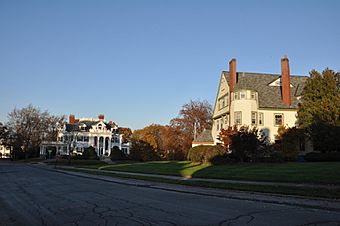Belvidere Hill Historic District facts for kids
Quick facts for kids |
|
|
Belvidere Hill Historic District
|
|

Two contributing properties
|
|
| Location | Lowell, Massachusetts |
|---|---|
| Area | 38 acres (15 ha) |
| Built | 1849 |
| Architectural style | Victorian, Colonial Revival |
| NRHP reference No. | 95000656 |
| Added to NRHP | May 26, 1995 |
The Belvidere Hill Historic District is a special neighborhood in Lowell, Massachusetts. It's famous for its beautiful homes built in the 1800s. This area started growing in the 1850s. It quickly became one of the best places to live in Lowell. Many important business and city leaders made their homes here. In 1995, this district was added to the National Register of Historic Places. This means it's a historically important place worth protecting.
Contents
Exploring Belvidere Hill's Past
Belvidere Hill is the highest spot in the city of Lowell. It sits on the east side of the city. This hill is actually a type of small, rounded hill called a drumlin. Drumlins are formed by glaciers, like huge ice bulldozers, pushing and shaping the land. Lowell has several of these drumlins. They are found east of the Concord River and south of the Merrimack River.
From Farmland to Fancy Homes
Before houses were built here, Belvidere Hill was farmland. In 1849, a company called the Proprietors of Locks and Canals bought land at the top of the hill. Back then, it was known as Lynde's Hill. They built a large water tank, called a reservoir, there. This reservoir was important for the city's factories. It helped provide water pressure to the industries. This was especially useful when the city's power canals were emptied for cleaning or repairs.
Why Belvidere Hill Became Popular
A road called Fairmount Road was built to help construct the reservoir. This road also made it easier for people to build homes on the hill. Business owners and political leaders in Lowell loved the idea of living there. One big reason was the amazing views. From Belvidere Hill, they could look away from the busy, crowded parts of the city. It offered a peaceful escape.
The District's Boundaries and Styles
The historic district is generally located between Wyman, Belmont, Fairview, and Nesmith Streets. Fairmount Street is the main road running through the middle of the district. It connects Mansur Street and Evergreen Road. The district also includes parts of Belmont and Nesmith Streets. These streets run parallel to Fairmount. Shorter streets like Talbot, Fairview, and Summit Streets are also part of the area. They connect Fairmount and Belmont.
Architectural Styles Over Time
The first houses built in this area were in styles like Italianate and Second Empire. These styles often featured grand designs and decorative details. The neighborhood continued to grow until around the year 1900. By then, popular styles included Queen Anne and Colonial Revival. Queen Anne homes are known for their varied textures and turrets. Colonial Revival homes often look like older American colonial houses. The plots of land for these homes were usually quite large, about half an acre to a full acre. Many houses also had a driveway in the front and a separate building for carriages in the back.



